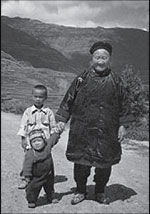The challenge was how to learn about the lives of women in rural China. The solution: provide them with cameras, teach them to use them, and let village women in Yunnan province create a collective self-portrait. Women between the ages of 18 and 57 took more than 40,000 photographs: 200 were selected for a traveling exhibition and 100 for a book, “Visual Voices: 100 Photographs of Village China by the Women of Yunnan Province.” The photographs and captions on these pages are from this book. This photographic journey was part of a U.S. and China initiative, funded by the Ford Foundation, to assess the reproductive health needs of women in rural areas of China. By taking pictures of life in their villages, the women provided public health officials with the ability to see them as they see themselves. The photographs created a common ground of understanding from which discussions emerged; such conversations—about health and work and change—might not have taken place without this visual record to prompt them.
As Mary Ann Burris of the Ford Foundation wrote in the forward to “Visual Voices,” the use of these photographs to generate conversation about aspects of rural life and the needs of women was “unique in contributing a positive and affirming map for change.” Not only did the photographs depict the difficulties these women confront, but within these images is an awareness of the hope, pride and humor of their lives, as well as their visions of the future.
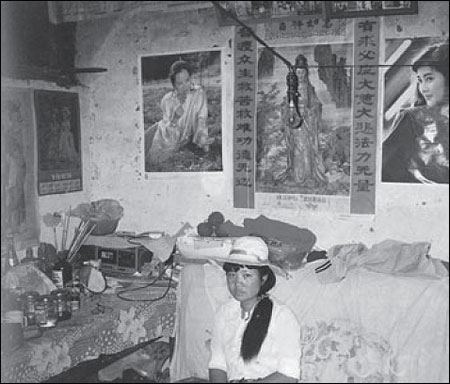
From a farmer’s indoor decorations and displays in the home, one can see that people’s ideas are changing. On the middle of the wall is a picture of the bodhisattva goddess that was put up by an elderly family member. Its significance is to bless the entire household with peace and health. On either side are movie star photographs put up by the girl. She hopes that her life will become more rich and colorful. Photo by Pang Mei Zhi, age 57.
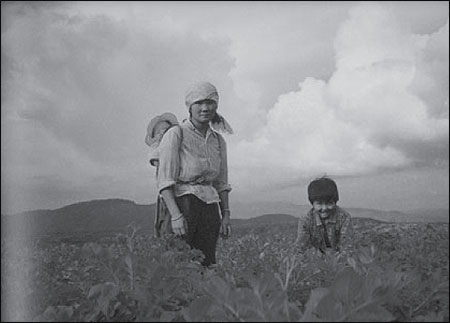
Tobacco planting in this local area yields a good income. With no one to help with day care, this woman’s only recourse is to bring her child to the field. Photo by Jie Xiu Mei, age 20.
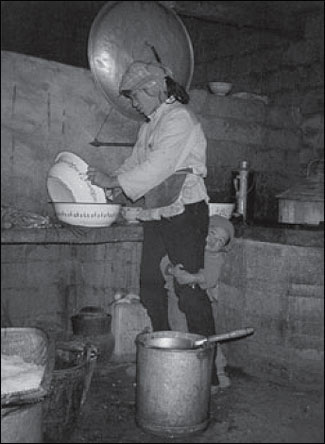
In our mountain area, all the children are cared for by the mother. When there is no elderly person to help, this young mother always keeps the child right by her side whether she has gone to till the field or has gone to do work at home. Photo by Tao Li Li, age 18.
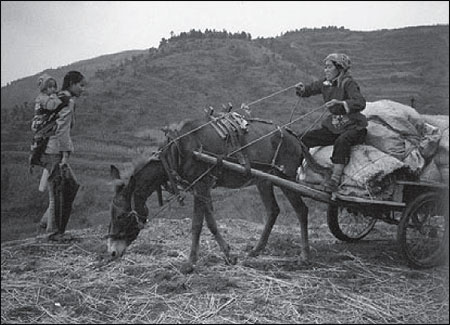
When women drive horse carts, it is no longer sensational news. In the past, women usually did not drive carts. Today, men and women are equal. Anything men can do, women can do, too. Photo by Zhao Ju Xian, age 34.
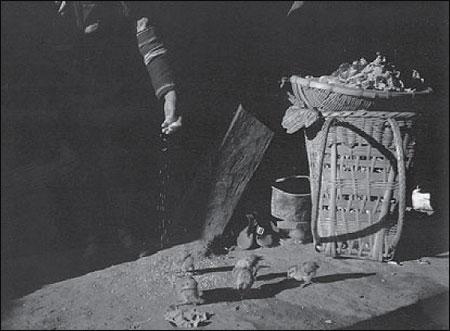
In Yi nationality mountain villages, rural women are known for their diligence and capability. They take up the farm work and production, do housework, raise the children, provide care for the old people, and at the same time raise livestock and poultry to subsidize the family expenses. Photo by Li Pu Zhao, age 49.
As Mary Ann Burris of the Ford Foundation wrote in the forward to “Visual Voices,” the use of these photographs to generate conversation about aspects of rural life and the needs of women was “unique in contributing a positive and affirming map for change.” Not only did the photographs depict the difficulties these women confront, but within these images is an awareness of the hope, pride and humor of their lives, as well as their visions of the future.

From a farmer’s indoor decorations and displays in the home, one can see that people’s ideas are changing. On the middle of the wall is a picture of the bodhisattva goddess that was put up by an elderly family member. Its significance is to bless the entire household with peace and health. On either side are movie star photographs put up by the girl. She hopes that her life will become more rich and colorful. Photo by Pang Mei Zhi, age 57.

Tobacco planting in this local area yields a good income. With no one to help with day care, this woman’s only recourse is to bring her child to the field. Photo by Jie Xiu Mei, age 20.

In our mountain area, all the children are cared for by the mother. When there is no elderly person to help, this young mother always keeps the child right by her side whether she has gone to till the field or has gone to do work at home. Photo by Tao Li Li, age 18.

When women drive horse carts, it is no longer sensational news. In the past, women usually did not drive carts. Today, men and women are equal. Anything men can do, women can do, too. Photo by Zhao Ju Xian, age 34.

In Yi nationality mountain villages, rural women are known for their diligence and capability. They take up the farm work and production, do housework, raise the children, provide care for the old people, and at the same time raise livestock and poultry to subsidize the family expenses. Photo by Li Pu Zhao, age 49.

